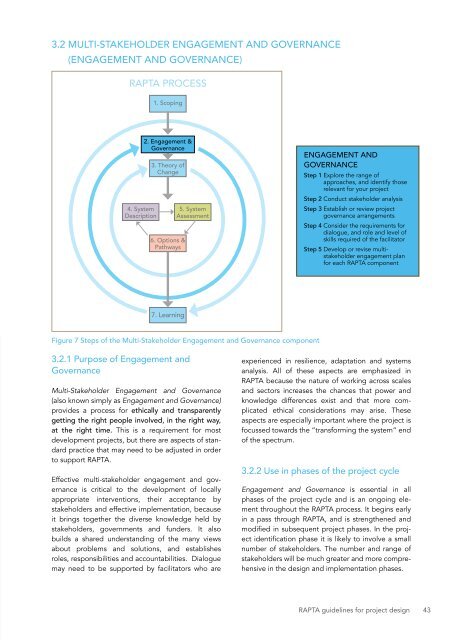DESIGNING PROJECTS IN A RAPIDLY CHANGING WORLD
srun3013fp1
srun3013fp1
Create successful ePaper yourself
Turn your PDF publications into a flip-book with our unique Google optimized e-Paper software.
3.2 MULTI-STAKEHOLDER ENGAGEMENT AND GOVERNANCE<br />
(ENGAGEMENT AND GOVERNANCE)<br />
RAPTA PROCESS<br />
1. Scoping<br />
4. System<br />
Description<br />
2. Engagement &<br />
Governance<br />
3. Theory of<br />
Change<br />
6. Options &<br />
Pathways<br />
5. System<br />
Assessment<br />
ENGAGEMENT AND<br />
GOVERNANCE<br />
Step 1 Explore the range of<br />
approaches, and identify those<br />
relevant for your project<br />
Step 2 Conduct stakeholder analysis<br />
Step 3 Establish or review project<br />
governance arrangements<br />
Step 4 Consider the requirements for<br />
dialogue, and role and level of<br />
skills required of the facilitator<br />
Step 5 Develop or revise multistakeholder<br />
engagement plan<br />
for each RAPTA component<br />
7. Learning<br />
Figure 7 Steps of the Multi-Stakeholder Engagement and Governance component<br />
3.2.1 Purpose of Engagement and<br />
Governance<br />
Multi-Stakeholder Engagement and Governance<br />
(also known simply as Engagement and Governance)<br />
provides a process for ethically and transparently<br />
getting the right people involved, in the right way,<br />
at the right time. This is a requirement for most<br />
development projects, but there are aspects of standard<br />
practice that may need to be adjusted in order<br />
to support RAPTA.<br />
Effective multi-stakeholder engagement and governance<br />
is critical to the development of locally<br />
appropriate interventions, their acceptance by<br />
stakeholders and effective implementation, because<br />
it brings together the diverse knowledge held by<br />
stakeholders, governments and funders. It also<br />
builds a shared understanding of the many views<br />
about problems and solutions, and establishes<br />
roles, responsibilities and accountabilities. Dialogue<br />
may need to be supported by facilitators who are<br />
experienced in resilience, adaptation and systems<br />
analysis. All of these aspects are emphasized in<br />
RAPTA because the nature of working across scales<br />
and sectors increases the chances that power and<br />
knowledge differences exist and that more complicated<br />
ethical considerations may arise. These<br />
aspects are especially important where the project is<br />
focussed towards the “transforming the system” end<br />
of the spectrum.<br />
3.2.2 Use in phases of the project cycle<br />
Engagement and Governance is essential in all<br />
phases of the project cycle and is an ongoing element<br />
throughout the RAPTA process. It begins early<br />
in a pass through RAPTA, and is strengthened and<br />
modified in subsequent project phases. In the project<br />
identification phase it is likely to involve a small<br />
number of stakeholders. The number and range of<br />
stakeholders will be much greater and more comprehensive<br />
in the design and implementation phases.<br />
RAPTA guidelines for project design 43


